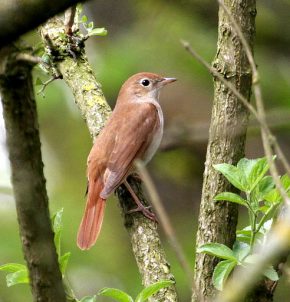
In late-April Nightingales are still returning to southern Britain, so this seems an appropriate time to recall Tolkien’s treatment of this exquisite songster. Tolkien refers to nightingales (mainly in passing) in a surprisingly high number of his works, but I’m not going to refer to them all here. Instead, I list all the titles of his books in which I’ve been able to locate an allusion to this species in the almost obligatory appendix. (I tried to time this blog post to coincide with the arrival of this species in the UK, so apologies for any rushed elements).
Nightingale (Luscinia megarhynchos) 16½ cm (6½ ins)
Quenya: lómelindё (dusk-singer); Sindarin: tinúviel (daughter of twilight)
The Natural History of the Nightingale
As Tolkien never provides a physical description of nightingales and only once attempts anything more than a brief evocation of listening to the effects of its song, what follow is a brief summary of the bird and its repertoire. A nightingale is a small brown songbird of the thrush family, or to be slightly more accurate, a chat, which is a particular sub-family of the thrushes. It is roughly intermediate in size between a robin and a song thrush. It is an unobtrusive bird and spends most of its time hidden in deep cover, which is why it has a large dark eye to enable it to locate its food of worms, beetles and other insects in semi-darkness. It will often raise its rufous-coloured tail while it forages on the ground where it can resemble the outline of a very large Wren.
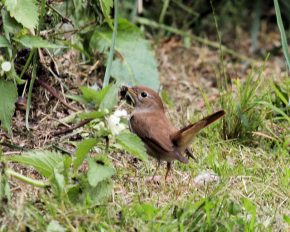
A nightingale’s physical appearance is understandably much less renowned than its stunningly-complex and amazingly-loud song. Although nightingales sing in the daylight as much as at night, the song becomes much more obvious in the dark when most other birds, apart from the much less musical owls, have become silent. It is believed that male nightingales arrive first and select some suitable habitat, and sing day and night to attract a migrating female out of the sky down to his territory. Perhaps it is appropriate here to state that all singing nightingales are male birds, although many poets used to assume that they were female. Scientists believe a male with a more complex song will attract a female more quickly, as his song is a way of illustrating that he is likely to be the most productive bird, and is therefore believed to be carrying the most successful genes to be passed on to the next generation. It is very hard to do justice to the remarkable qualities of its song in words, but this is Richard Mabey’s attempt:
“there is a flourish of piping notes to begin with, sometimes in triplets or short arpeggios, and often with an urgent, whiplash quality; then a single note repeated as a rich, liquid bubbling or chuckling or slow trill…the bird’s signature tune…is a sequence of long, sighing, indrawn whistles, mounting in a crescendo on a single note until they fall, dramatically to a deep rattle.”
In addition to Mabey’s comments it is worth adding that the nightingale’s habit of giving a fairly lengthy pause between each ‘aria’ raises similarities between the bird and opera singers.
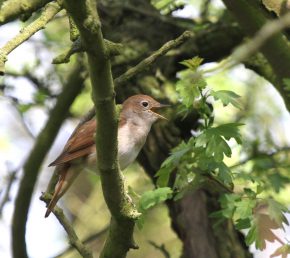
The nightingale’s song is justifiably famous, but each year it is only heard for a relatively short period. The first males start to arrive about mid-April and sing both night and day for hours at a time, but once a male has paired up he will sing for shorter periods, and by the end of May there will be relatively few nightingales singing, and by the beginning of July none at all. You may hear a nightingale singing at the RSPB website here: http://www.rspb.org.uk/discoverandenjoynature/discoverandlearn/birdguide/name/n/nightingale/index.aspx
The Poetic Heritage
The nightingale’s song has been the subject of poetic English literature for well over one thousand three hundred years. One of the earliest surviving poems about the bird is an Old English riddle by William of Malmesbury believed to have been written around 650 AD. Tolkien lectured on the early Middle English Poem The Owl and the Nightingale, and even worked on a translation of it, which he probably left unfinished. In early literature the nightingale tended to be seen as “cheerful, engaging birds, the friends and confidants of lovers”, but the situation changed in Renaissance times when the bird became associated with more illicit “sexual frolicking” (Mabey p.12). Other more recent noteworthy contributions to the literary tradition have been provided by John Keats, Samuel Taylor Coleridge, Mary Robinson, Robert Louis Stevenson and John Clare. Only the latter has ornithological, as well as poetic value. To generalise, the Romantic poets reclaimed the nightingale’s song as a thing of joy (Cocker, p.342). In the twentieth century T.S. Eliot’s influential interpretation in The Waste Land of the bird was associated with the “fragmented, loveless character of modern sexual relations” (Cocker, Ibid).
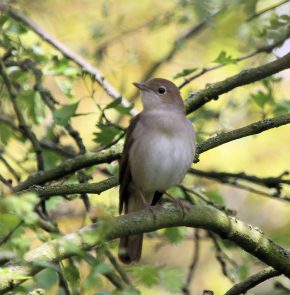
It is unsurprising that Tolkien’s use of the nightingale has more kinship with the early literature and the Romantic poets than with Eliot. An excellent survey of the literature and folk-lore, and descriptions of personal encounters with the nightingale, may be found in Richard Mabey’s Whistling in the Dark (1993), and in The Barley-Bird: Notes on the Suffolk Nightingale (2010). Mabey’s thoughts on the species are distilled in the entry for the bird in Mark Cocker’s Birds Britannica (2005). This small, apparently insignificant bird, over the past millennia, has accreted a disproportionate amount of cultural baggage, but how has Tolkien engaged with the species?
Tolkien’s Inspiration
Ever since the publication of Humphrey Carpenter’s biography in 1977 it has become well-known among Tolkien readers that Tolkien was inspired to write the tale of Beren and Lúthien after his wife danced and sang for him in a glade with ‘hemlocks’ (cow parsley) near Roos, East Yorkshire during World War One. The importance of this event in Tolkien’s literary imagination cannot be over-estimated. He continued to write variations of their encounter for many decades; as Dimitra Fimi has summarised it “was first written in 1917 and exists in at least another eight versions, the latest written in the 1950s” (p.2). Of all the characters he invented, it is the names Lúthien and Beren which appear on his and his wife’s gravestone. Unfortunately, it seems unlikely that Edith Tolkien’s dance was accompanied by nightingales in Roos. There are no Nightingales in the Roos area now, nor have there been for many decades. However, it is just possible they may have been present one hundred years ago, so this is an area that warrants more research.
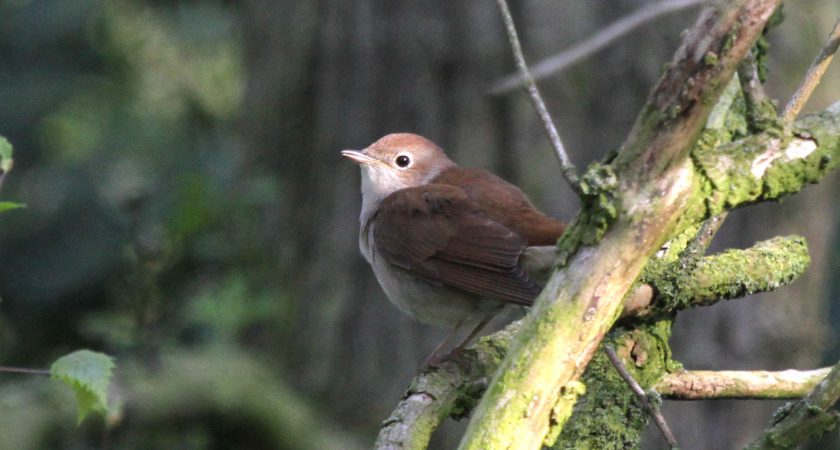
Occasionally, the blackcap, a member of the warbler family, is called the northern nightingale, so it may have been this species which sang in Roos, or just as plausibly a song thrush or even a blackbird. Perhaps the bird song was completely imaginary, as the most common sounds in Dents Garth on an early summer evening now are from the extremely noisy rookery. The nightingale has not bred above the Humber in large numbers in recent decades, but there are ancient reports of them breeding as far north as Boroughbridge. Although occasional individual males still overshoot their territories and are heard singing for a few hours or even days in Yorkshire, the bird is declining locally. Even the apparently healthy 1990s colony of a dozen singing males on Thorne Moors near Doncaster became extinct within the last decade. One of the factors is believed to be the burgeoning population of several species of deer, including some which have been introduced. These deer are heavily grazing the thick undergrowth needed by the species. The nightingale population in Arda is more secure, as the many wolves keep the numbers of deer in check!
The Nightingale in Tolkien’s writings
Many readers’ first encounter with the nickname Tinúviel probably occurs when Aragorn relates Beren and Lύthien’s basic story initially in a poem, followed by a prose explanation to the Hobbits shortly before the attack of the Nazgûl on Weathertop in The Lord of the Rings (1954-5). However, Tolkien had been utilizing the word Tinúviel for decades in his unpublished writings.
In Tolkien’s work the nightingale is most closely associated with Lύthien, the daughter of Melian, the Maia, and Thingol. In The Silmarillion when Beren first sees Lύthien he names her Tinúviel, which is nightingale in the language of the Grey-elves. Later, when Beren hears her singing it is described as keen and heart-piercing. “Heart-piercing” were the same words used by the romantic poet and actress Mary Robinson (c.1757-1800) in her ode to the bird, but they are not specific enough to suggest Tolkien may have read and remembered her poetry. However, there is no doubt that “keen” and “heart-piercing” are much more appropriate epithets to describe the song of the nightingale than that of the lark, which Tolkien likens her song to at this point of the narrative (p.165).
Rather interestingly, in the earliest-surviving version of the ‘Tale of Tinúviel’ the name of Lúthien does not even appear, and Tinúviel is her given name. In the emerging mythology Lúthien was originally the name the elves of Tol Eressёa gave to a male character – Ælfwine. So, the nickname Tinúviel, the word for nightingale, predates the invention of the name Lúthien by several years.
In the Silmarillion Lúthien arrives at Tol-in-Gaurhoth where Beren lies imprisoned and demoralised by Sauron. When she sings he imagines the stars shining above his head and nightingales singing in the trees. This gives him the brief strength to sing “a song of challenge that he had made in praise of the Seven Stars”, which are a sign of the fall of Morgoth. Beren collapses after the effort of singing, but his song revealed his presence, and in turn leads Lúthien to sing a song of greater power, which causes Sauron to send out a series of wolves, which are each defeated by Huan, until Sauron cloaks himself in the form of a werewolf, and after an epic struggle he is forced to abandon his stronghold to Lúthien, who is then able to rescue Beren. In this example the nightingales are linked with a dream-world, but one which permits the ‘dreamer’ to accomplish a final act of defiance, which eventually leads to his subsequent liberation.
Although the connection between Lúthien and nightingales is the most obvious example, her mother, Melian is also strongly linked to this species. In The Silmarillion Melian originally lives in Lórien in Valinor where she is said to have taught nightingales their song, so that they “sang about her wherever she went” (p.30). Melian left Valinor when the Quendi woke and she brought her nightingales with her and “she filled the silence of Middle-earth before the dawn with her voice and the voices of her birds” (p.55). Later, King Elwë (Thingol) was passing Nan Elmoth when he hears nightingales. His search for the birds leads him directly to Melian where he falls under an enchantment. Tolkien therefore uses nightingales here both to increase the romantic aspects of the narrative, but also as a direct means, it doesn’t feel quite appropriate to use the phrase “plot device” of bringing Thingol to Melian, and in due course the birth of Lúthien. On this occasion nightingales could also be argued to be an unwitting partial agent of eventual disaster. Once Thingol falls under Melian’s spell he is described as “lost” and “he forgot then utterly all his people” (Ibid.). Therefore, from the point of view of the Teleri, it could be argued that Thingol’s role as leader of his people has been fatally undermined because he heeded the songsters. If he had continued to lead his people then it is possible that the future disastrous consequences of the kinslaying would never have taken place, nor ultimately the sacking of Doriath.
The earliest surviving reference to nightingales in Tolkien’s posthumously published writings is in the apparently unsophisticated poem ‘You and Me and the Cottage of Lost Play’ (April 1915), which merely includes the brief name-check: “while all about the nightingales/were singing in the trees” (BOLT1, p.28). The quote above survived intact into the latest version of the poem which may have been worked on as late as 1962. In this situation Tolkien seems to have merely utilised the nightingale to enhance the romantic atmosphere of the couple in the poem. John Garth has argued convincingly that the boy and girl in the poem are representations of Tolkien and Edith as children, so this is another earlier-written instance of Edith and Ronald being associated with these traditional birds of romantic love (Garth, p.72).
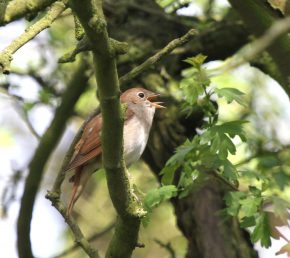
Later, in the link between The Cottage of Lost Play and the The Music of the Ainur, just before sleeping, Eriol (who later became Ælfwine) hears the sudden song of a nightingale through the open window. The song seems to bleed into his dreams because he heard a music in the dream: “thinner and more pure than any he heard before, and it was full of longing” (Ibid, p.46). There then follows Tolkien’s most evocative description of the images conveyed by the nightingale’s song:
“it was if pipes of silver or flutes of shape most slender-delicate uttered crystal notes and threadlike harmonies beneath the moon upon the lawns.” (Ibid)
In this preliminary introduction to the cosmology the nightingales could be argued to act as a bridge between Eriol’s world of mankind, and the first description of the much earlier events of the Music of the Ainur, although this conception was subsequently dropped.
An occurrence in Tolkien’s own childhood predates the use of the species in his fiction. Tolkien’s young cousins, Marjorie and Mary Incledon, invented a language which they called ‘Animalic’, in which “nightingale” was seemingly chosen rather arbitrarily as an equivalent to the English word “are” (A Secret Vice, p.9 and note 18). So far, so seemingly trivial, but is it coincidental that one of the first words one of Tolkien’s characters learns on encountering another language seems to echo Tolkien’s childhood experience? In the surviving text of The Lost Road, Alboin has a series of dreams from which he awakes and remembers fragments of a new language. One of the earliest words he learns is lömelindё, which he realises means nightingale (p.41). Alboin is a budding philologist, and there are a number of similarities between his character and that of Tolkien. Whether Tolkien deliberately linked his own youthful experience of the nightingale in the very primitive childish new language of his cousins, with that of his character encountering a far more advanced well-considered imaginary language seems possible, but probably cannot be established with any certainty.
Later, in The Lost Road Elendil and his son are discussing the consequences of Sauron’s arrival on Númenor, when a nightingale (lómelindё) suddenly bursts into song. The adjective Tolkien selects to describe the song is “thrilling”, which although completely appropriate is not a typical response, unless one has actually had a personal experience of the bird suddenly rending the darkness of the evening with its heart-stopping song. The nightingale’s song is then joined by the voice of the maiden Fíriel, singing from a high position, which seems to silence the bird. While the nightingale was described as “thrilling”, the word which appears twice in association with Fíriel’s is “sadly” (pp.62-3). It seems likely that Fíriel was going to reappear in the narrative, but the significance of her role and any comparison with the nightingale remain conjectural as the fragment of The Lost Road ends before she makes a reappearance. In the surviving rudimentary notes provided by Christopher Tolkien, there is no further mention of her role, so it is possible Fíriel was merely added as a melancholy counterpoint to the thrilling nightingale in a fragment which already includes many hints of approaching calamity.
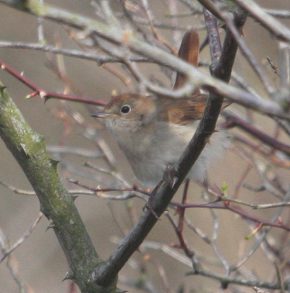
From the single reference in The Lord of the Rings it would appear that Tolkien merely uses the nightingale to enhance the romantic credentials of the story being related, but when some of the posthumously published references are considered a more complex picture emerges. Yes, Tolkien often highlights the virtuosity of its song, but its use in other texts implies a greater significance. In The Lost Road the use of nightingale is a means of beginning to assemble the building-blocks of an unfamiliar (imaginary) language, which can be seen to have a vague autobiographical link to the author’s own early unsteady attempts at understanding an imaginary language. Of course as several of the narratives in which nightingales appeared remained unfinished, it isn’t always possible to judge if Tolkien had a more nuanced role in mind for this species. The cumulative effect of the nightingale being mentioned in such a great number of texts makes one wonder if the species had a totemic importance for Tolkien. The implications of the word nightingale in each text taken together resonates in the mind of this reader out of all proportion to the amount of text allocated to this truly iconic songster. This spring why not try to have an aural encounter with this enigmatic, magical species before it is lost as a British breeding bird, and muse on and remember the scenes in Tolkien’s writings in which the song is mentioned?
APPENDIX
Tolkien Texts in which Nightingales are mentioned
The Lord of the Rings: 50th Anniversary Edition, London: Harper Collins, 2002.
The Silmarillion, edited by Christopher Tolkien, London: George Allen & Unwin, 1977.
The Letters of J.R.R. Tolkien, edited by Humphrey Carpenter, London: George Allen & Unwin, 1981.
The Monsters and the Critics & Other Essays, edited by Christopher Tolkien, London: 1982.
Roverandom, edited by Wayne Hammond & Christina Scull, London: HarperCollins, 1998.
A Secret Vice: Tolkien on Invented Languages, edited by Dimitra Fimi & Andrew Higgins, HarperCollins, 2016.
The History of Middle-earth
The Book of Lost Tales: Part 1, edited by Christopher Tolkien, London: George Allen & Unwin, 1983.
The Book of Lost Tales: Part 2, edited by Christopher Tolkien, London: George Allen & Unwin, 1984
The Lays of Beleriand, edited by Christopher Tolkien, London: George Allen & Unwin, 1985.
The Shaping of Middle-earth, edited by Christopher Tolkien, London: George Allen & Unwin, 1986
The Lost Road, edited by Christopher Tolkien, London: Unwin Hyman, 1987.
Sauron Defeated, edited by Christopher Tolkien, London: HarperCollins, 1992.
Morgoth’s Ring, edited by Christopher Tolkien, London: HarperCollins, 1993.
The War of the Jewels, edited by Christopher Tolkien, London: Harper Collins, 1994.
Other works consulted
Humphrey Carpenter, J.R.R. Tolkien: a Biography, London: George Allen & Unwin, 1977.
Dimitra Fimi, Tolkien, Race and Cultural History: From Fairies to Hobbits, Palgrave Macmillan, 2010.
John Garth, Tolkien and the Great War, London: HarperCollins, 2003.
Wayne Hammond & Christina Scull, The J.R.R. Tolkien Companion & Guide: A Reader’s Guide, London: HarperCollins, 2006.
Phil Mathison, Tolkien in East Yorkshire: Newport: Dead Good, 2012.
Nightingale Sources
Mabey, Richard. Whistling in the Dark: in Pursuit of the Nightingale, London: Vintage, 1993.
Cocker, Mark & Richard Mabey (eds.), Birds Britannica, London: Chatto & Windus, 2005.
Chas A Holt, Chris M. Hewson & Robert J. Fuller, “The Nightingale in Britain: Status, Ecology & Conservation needs” in British Birds, Vol. 105, pp.172-187, 2012.